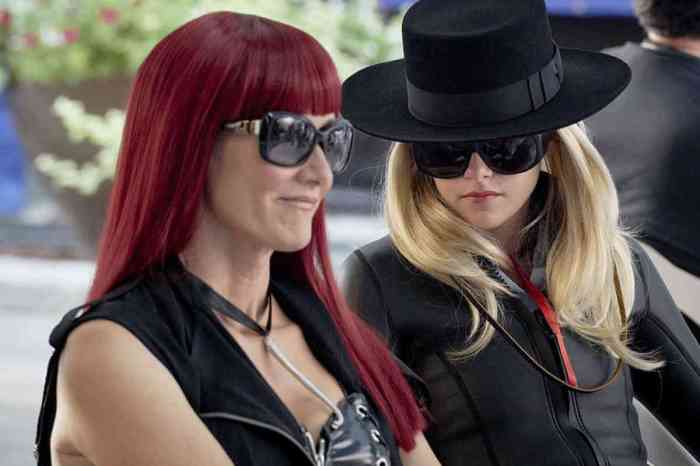Laura Albert, Savannah Knoop, and and Asia Argento in Jeff Feuerzeig’s “Author: The JT Leroy Story.” | AMAZON STUDIOS / MAGNOLIA PICTURES
It’s not necessarily exploitative for a writer to be a recluse or use a pseudonym. Elena Ferrante is one of Italy’s most celebrated contemporary writers, and no one knows who she is, although consensus holds that she’s really a woman. Thomas Pynchon and J.D. Salinger used their real names, but they shied away from the camera and never gave interviews.
But Laura Albert, who created the persona of queer and trans teen waif JT Leroy and published two novels and one book of short stories as him, is a different case.
For starters, she began using the Leroy persona to call psychological crisis centers. Before Leroy started writing his popular short stories, he was a telephone-only patient of shrink Dr. Terrence Owens, and Albert seems to have recorded all their years’ worth of sessions. (I’m referring to Leroy with masculine pronouns because Albert does, despite the persona’s strong hints of gender ambiguity.) Albert used people in a way that Ferrante hasn’t, and she also exploited drug addicts, HIV-positive people, and the trans community along the way in creating Leroy’s backstory.
Offering Laura Albert apologia, Jeff Feuerzeig dodges tough questions about “JT Leroy”
Jeff Feuerzeig’s documentary “Author: The JT Leroy Story” — counting a program on the ID cable channel, the third Leroy doc made so far — doesn’t have a skeptical bone in its body. It’s content to gawk at the mess Albert made of her life and claim it’s a profound statement about fame and identity.
Albert began writing short stories in the late ‘90s, one of which was published in an anthology of memoirs. She claims she tried to give up fiction, but she ended up writing the acclaimed novel “Sarah.” As it propelled Leroy to fame, her sister-in-law Savannah Knoop, wearing a wig and sunglasses, took on the task of incarnating the writer in person. (He was supposedly too shy to appear at his own readings, so Winona Ryder and Matthew Modine read from “Sarah” at early club dates.) Eventually, “Sarah” led to movie deals and fashion spreads for Leroy, but the fact that the author didn’t really exist was exposed.
There are aspects of the JT Leroy story Feuerzeig left on the cutting room floor, probably because they’d make Laura Albert look bad. Albert started out contacting a group of writers whose work dealt with issues of sex and violence in a way superficially similar to hers, including Mary Gaitskill, Bruce Benderson, and Dennis Cooper. With hindsight, one can see that she tailored the Leroy persona to appeal to these authors, in fact. Benderson and Cooper are interviewed in “Author,” but the film doesn’t discuss the way Leroy emotionally manipulated them by constantly calling at all hours of the day claiming he was about to commit suicide. If Albert was genuinely suicidal, it’s odd that she would funnel such intense feelings through a persona. Watching the film, I kept thinking, “She needs help, and she’s not going to get it by talking to her psychiatrist as a person who doesn’t exist.”
Albert has a point when she insists that her work was always published as fiction and that her reputation shouldn’t have suffered so much when its true authorship was revealed. She says that she always felt more comfortable writing about the sexual abuse she suffered if presented from the perspective of a comparable male victim. But why didn’t she write the same stories about male Southern Baptist prostitutes and the truck stops they haunt under her real name? I think it would have quickly become obvious that the Flannery O’Connor and William Faulkner comparisons she received on a Canadian talk show excerpted in “Author” were wildly overinflated. “Sarah” was always sold as a novel with the frisson of its author’s backstory, giving its readers the thrill of secondhand degradation.
For her part, Albert admits that the first truck stop she ever visited was on the set of Asia Argento’s film of her story “The Heart Is Deceitful Above All Things.” So much for a life of teenage prostitution at truck stops across the South!
As “Author” progresses, it goes from cute animation — if that applies to a depiction of a teenage junkie shooting up — to endless images of tapes from celebrities like Billy Corgan and Courtney Love playing in an answering machine. The film is slickly made. That only makes its apologia for Albert worse. The woman clearly had and still has numerous problems: an addiction to food that led to childhood teasing about her weight and eventual surgery to prevent diabetes, a frightening ability to switch back and forth between personae. Even without the New York magazine and New York Times articles that destroyed the JT Leroy persona, something was going to give.
But “Author” gives Albert the last word in a way that made me faintly nauseous. She describes abusive games at the hand of her uncle, blaming them for the entire course of her life. So it’s okay to manipulate other people while using them to climb the social ladder because you had a rough childhood? If that’s the case, there are millions of potential JT Leroys out there. Can a memoir possibly be far behind?
AUTHOR: THE JT LEROY STORY | Directed by Jeff Feuerzeig | Amazon Studios/ Magnolia Pictures | Opens Sep. 9 | Film Society of Lincoln Center, 165 W. 65th St. | filmlinc.org | Landmark Sunshine, 143 E. Houston St., btwn. First & Second Aves. | landmarktheatres.com

































